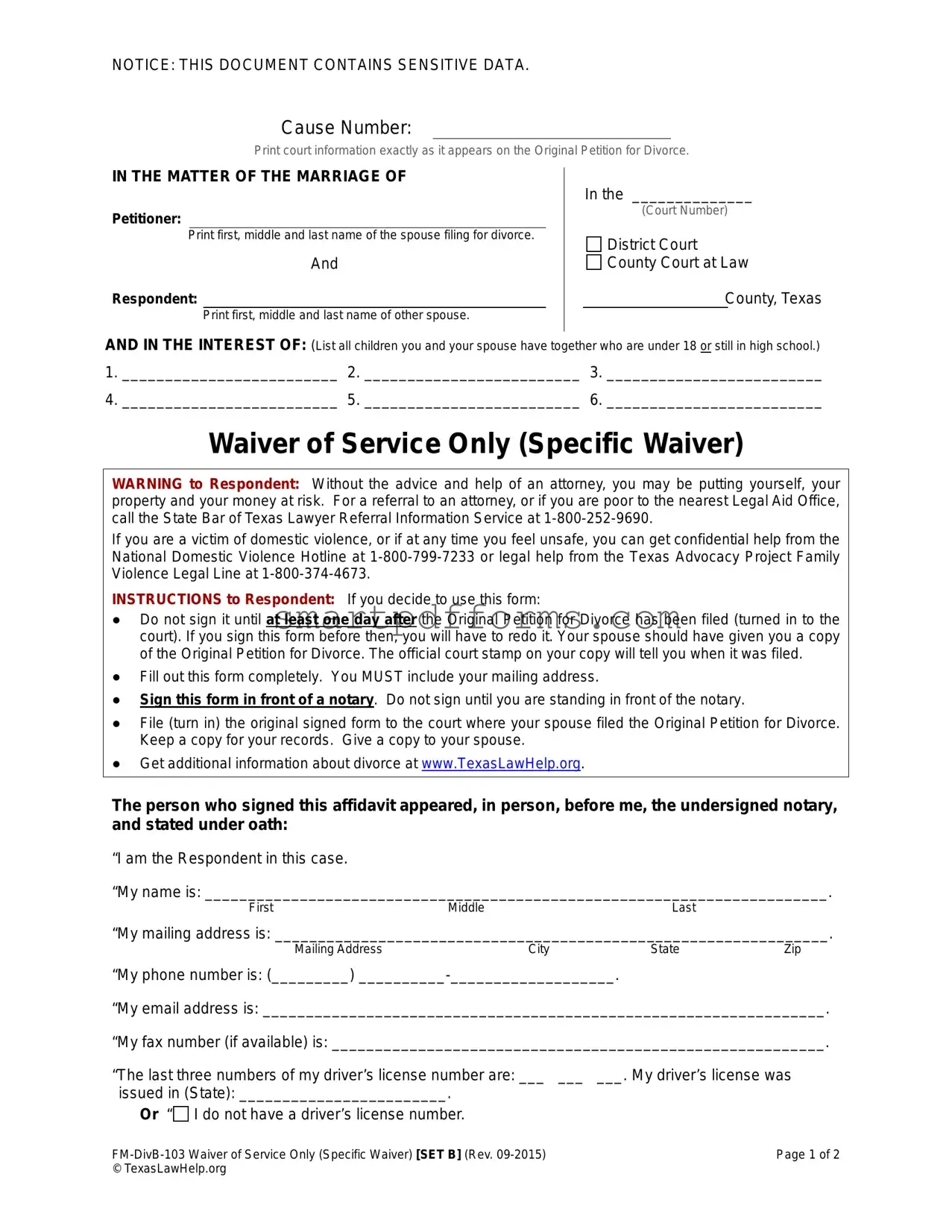NOTICE: THIS DOCUMENT CONTAINS SENSITIVE DATA.
Cause Number:
Print court information exactly as it appears on the Original Petition for Divorce.
IN THE MATTER OF THE MARRIAGE OF |
In the ______________ |
|
|
Petitioner: |
(Court Number) |
|
|
Print first, middle and last name of the spouse filing for divorce. |
□ District Court |
|
|
|
And |
□ County Court at Law |
Respondent: |
County, Texas |
Print first, middle and last name of other spouse.
AND IN THE INTEREST OF: (List all children you and your spouse have together who are under 18 or still in high school.)
1._________________________ 2. _________________________ 3. _________________________
4._________________________ 5. _________________________ 6. _________________________
Waiver of Service Only (Specific Waiver)
WARNING to Respondent: Without the advice and help of an attorney, you may be putting yourself, your property and your money at risk. For a referral to an attorney, or if you are poor to the nearest Legal Aid Office, call the State Bar of Texas Lawyer Referral Information Service at 1-800-252-9690.
If you are a victim of domestic violence, or if at any time you feel unsafe, you can get confidential help from the National Domestic Violence Hotline at 1-800-799-7233 or legal help from the Texas Advocacy Project Family Violence Legal Line at 1-800-374-4673.
INSTRUCTIONS to Respondent: If you decide to use this form:
●Do not sign it until at least one day after the Original Petition for Divorce has been filed (turned in to the court). If you sign this form before then, you will have to redo it. Your spouse should have given you a copy of the Original Petition for Divorce. The official court stamp on your copy will tell you when it was filed.
●Fill out this form completely. You MUST include your mailing address.
●Sign this form in front of a notary. Do not sign until you are standing in front of the notary.
●File (turn in) the original signed form to the court where your spouse filed the Original Petition for Divorce. Keep a copy for your records. Give a copy to your spouse.
●Get additional information about divorce at www.TexasLawHelp.org.
The person who signed this affidavit appeared, in person, before me, the undersigned notary, and stated under oath:
“I am the Respondent in this case.
“My name is: ________________________________________________________________________.
FirstMiddleLast
“My mailing address is: ________________________________________________________________.
Mailing AddressCityStateZip
“My phone number is: (_________) __________-___________________.
“My email address is: _________________________________________________________________.
“My fax number (if available) is: _________________________________________________________.
“The last three numbers of my driver’s license number are: ___ ___ |
___. My driver’s license was |
issued in (State): ________________________. |
|
Or “□ I do not have a driver’s license number. |
|
FM-DivB-103 Waiver of Service Only (Specific Waiver) [SET B] (Rev. 09-2015) |
Page 1 of 2 |
© TexasLawHelp.org |
|

“The last three numbers of my social security number are: ___ ___ ___. Or “□
 I do not have a social security number.
I do not have a social security number.
“I have been given a copy of the Original Petition for Divorce filed in this case. I have read the Original Petition for Divorce and understand what it says. I do not give up my right to review a different Petition for Divorce if it gets changed (amended).
“I understand that I have the right to be given a copy of the Original Petition for Divorce by a constable, sheriff or other official process server (legal notice). I do not want to be given legal notice. I give up my right to legal notice.
“I ask that the Court not enter any orders in this case unless the order is signed by me or unless I have received prior written notice of the date, time, and place of hearing.
“If I reach an agreement and sign a Final Decree of Divorce, the court can enter the Decree without me being present and without giving me notice. If I sign an agreed Final Decree of Divorce, I do not want a court reporter to make a record of the testimony.
“I understand that by signing this form I am entering an appearance in this case. I agree that a Judge or Associate Judge in the county and state where this case is filed may make decisions about my divorce, even if the divorce should have been filed in another county.
“I understand that I must let the Court and my spouse’s attorney (or my spouse if s/he is not represented by an attorney) know in writing if my mailing address or email address changes during this case. If I don’t, then I understand that any notices about this case will be sent to me at the mailing address or email address on this form.
Military Status (Check one box.)
“□
 I am not in the military.
I am not in the military.
“□
 I am in the military. I agree to the provisions stated above and I waive only the rights, privileges, and exemptions I have under the Servicemember’s Civil Relief Act that are contrary to those provisions.
I am in the military. I agree to the provisions stated above and I waive only the rights, privileges, and exemptions I have under the Servicemember’s Civil Relief Act that are contrary to those provisions.
Name Change (Check one box.)
“□
 I am NOT asking the court to change my name.
I am NOT asking the court to change my name.
“□
 I ask the Court to change my name back to a name I used before my marriage. I am not asking the court to change my name to avoid criminal prosecution or creditors.”
I ask the Court to change my name back to a name I used before my marriage. I am not asking the court to change my name to avoid criminal prosecution or creditors.”
_________________________________________________________________________________________
► -------
-------
Signature of Respondent (Do NOT sign until you are in front of a notary.)
Notary fills out below.
State of
(Print name of state where this Affidavit is notarized)
County of
(Print the name of the county where this Affidavit is notarized)
Sworn to and subscribed before me, the undersigned notary, on this date: |
|
/ |
/ |
at |
|
a.m./p.m. |
Month |
day |
year |
|
|
|
|
|
time |
|
circle one |
|
|
|
by
(Print name of person who is signing this Affidavit. NOT the notary’s name.)
|
[Notary Stamps Here ] |
|
|
|
►Notary’s----Signature |
|
|
|
FM-DivB-103 Waiver of Service Only (Specific Waiver) [SET B] (Rev. 09-2015) |
|
Page 2 of 2 |
|
© TexasLawHelp.org |
|
|




 I do not have a social security number.
I do not have a social security number.
 I am not in the military.
I am not in the military.
 I am in the military. I agree to the provisions stated above and I waive only the rights, privileges, and exemptions I have under the Servicemember’s Civil Relief Act that are contrary to those provisions.
I am in the military. I agree to the provisions stated above and I waive only the rights, privileges, and exemptions I have under the Servicemember’s Civil Relief Act that are contrary to those provisions.
 I am NOT asking the court to change my name.
I am NOT asking the court to change my name.
 I ask the Court to change my name back to a name I used before my marriage. I am not asking the court to change my name to avoid criminal prosecution or creditors.”
I ask the Court to change my name back to a name I used before my marriage. I am not asking the court to change my name to avoid criminal prosecution or creditors.”